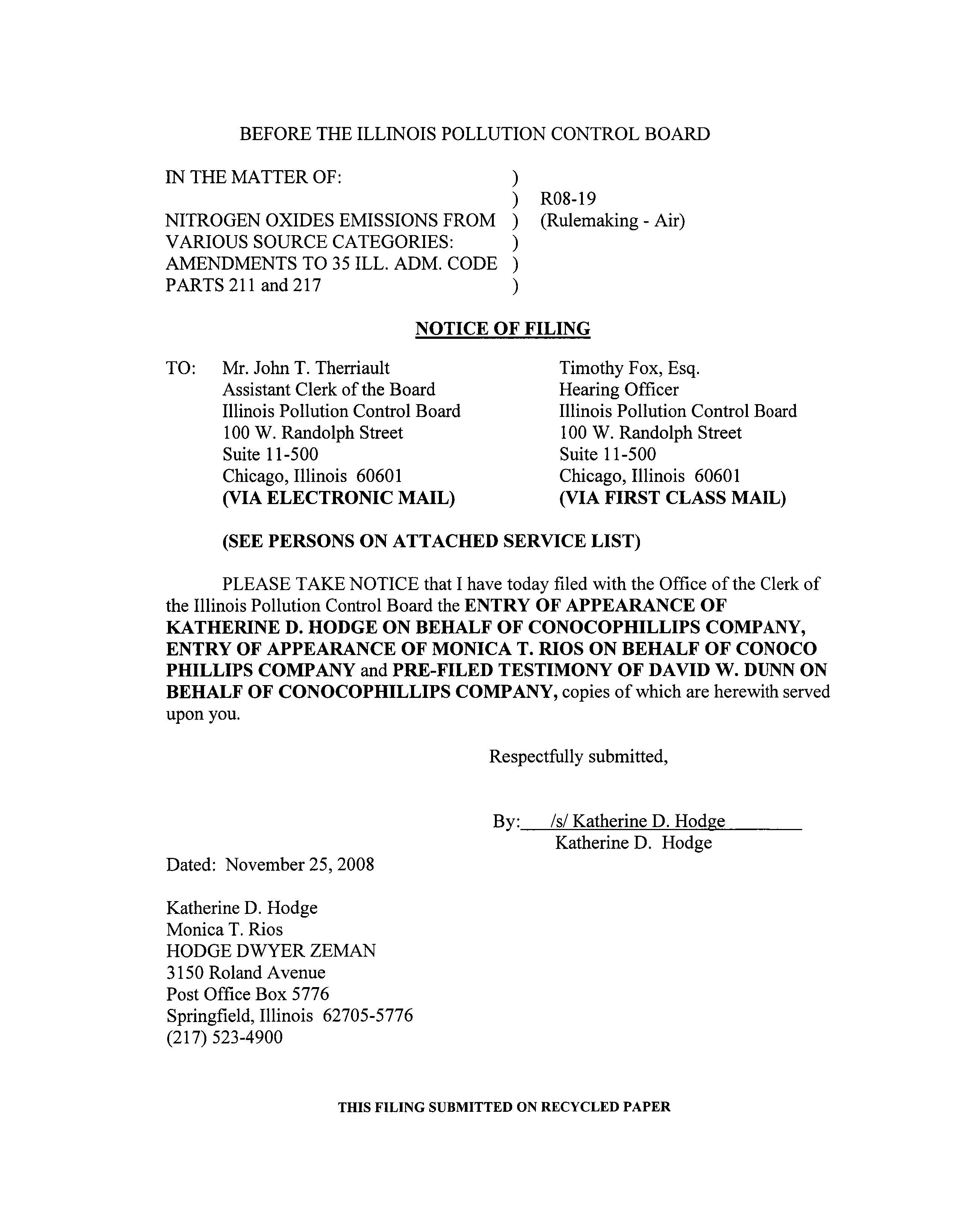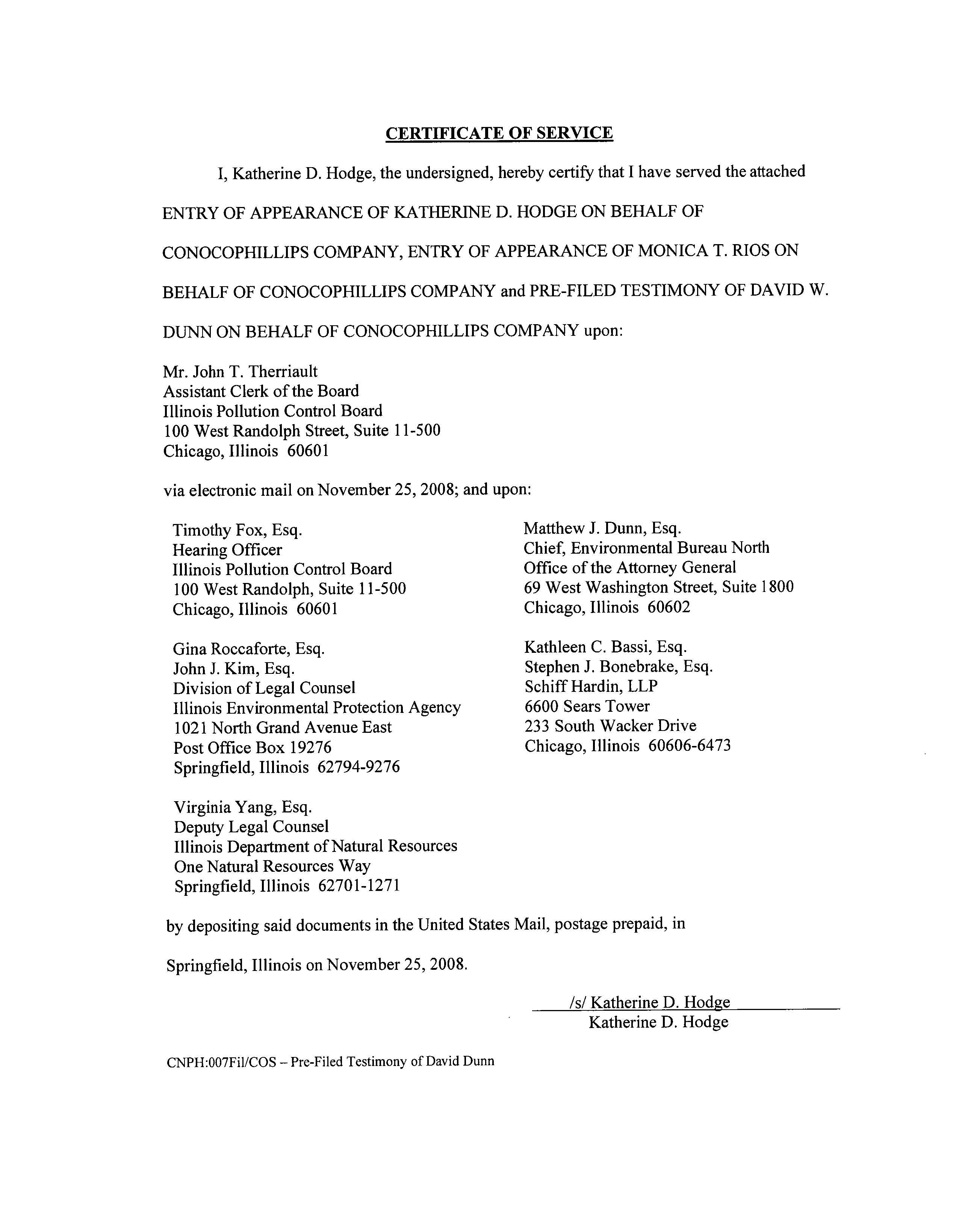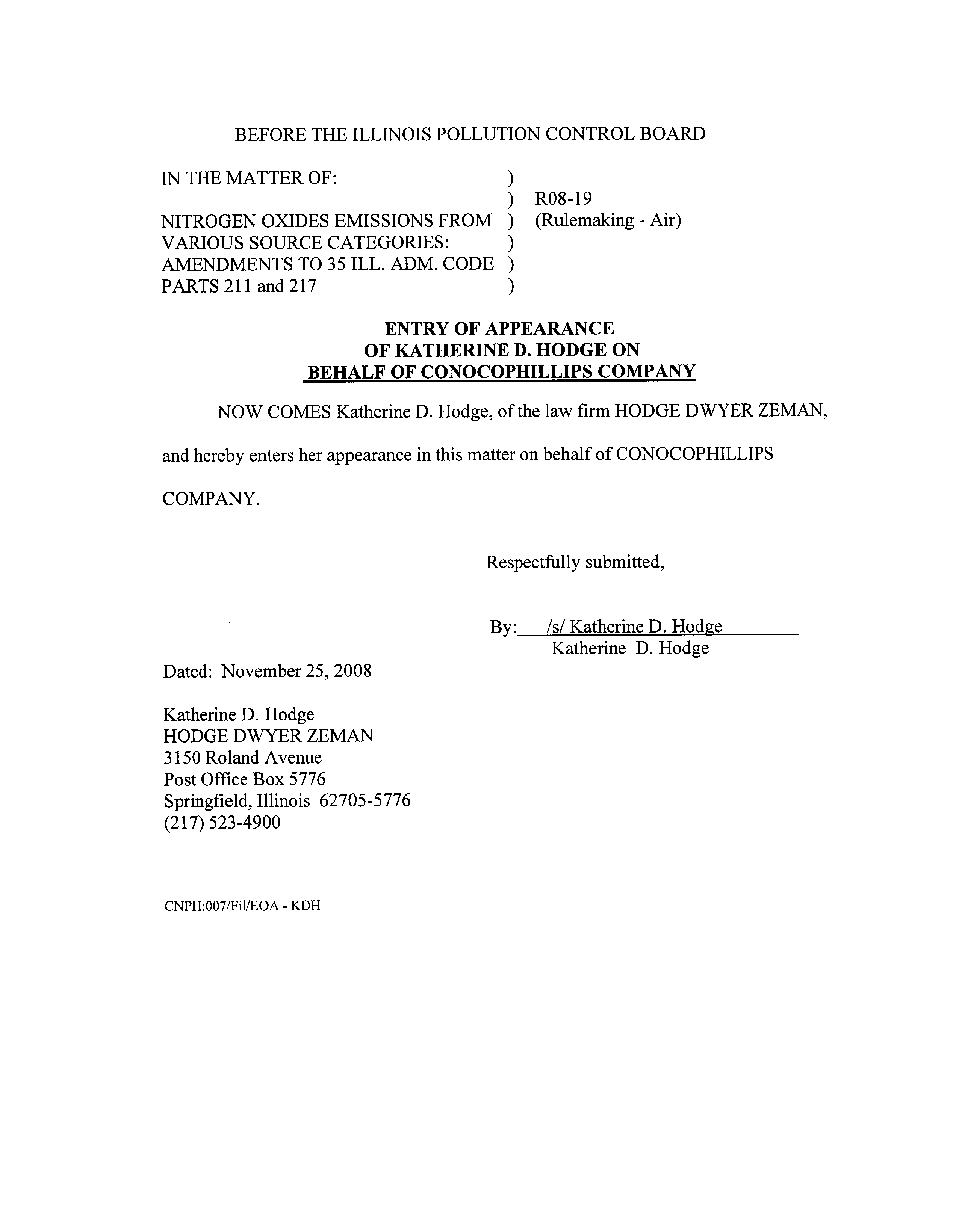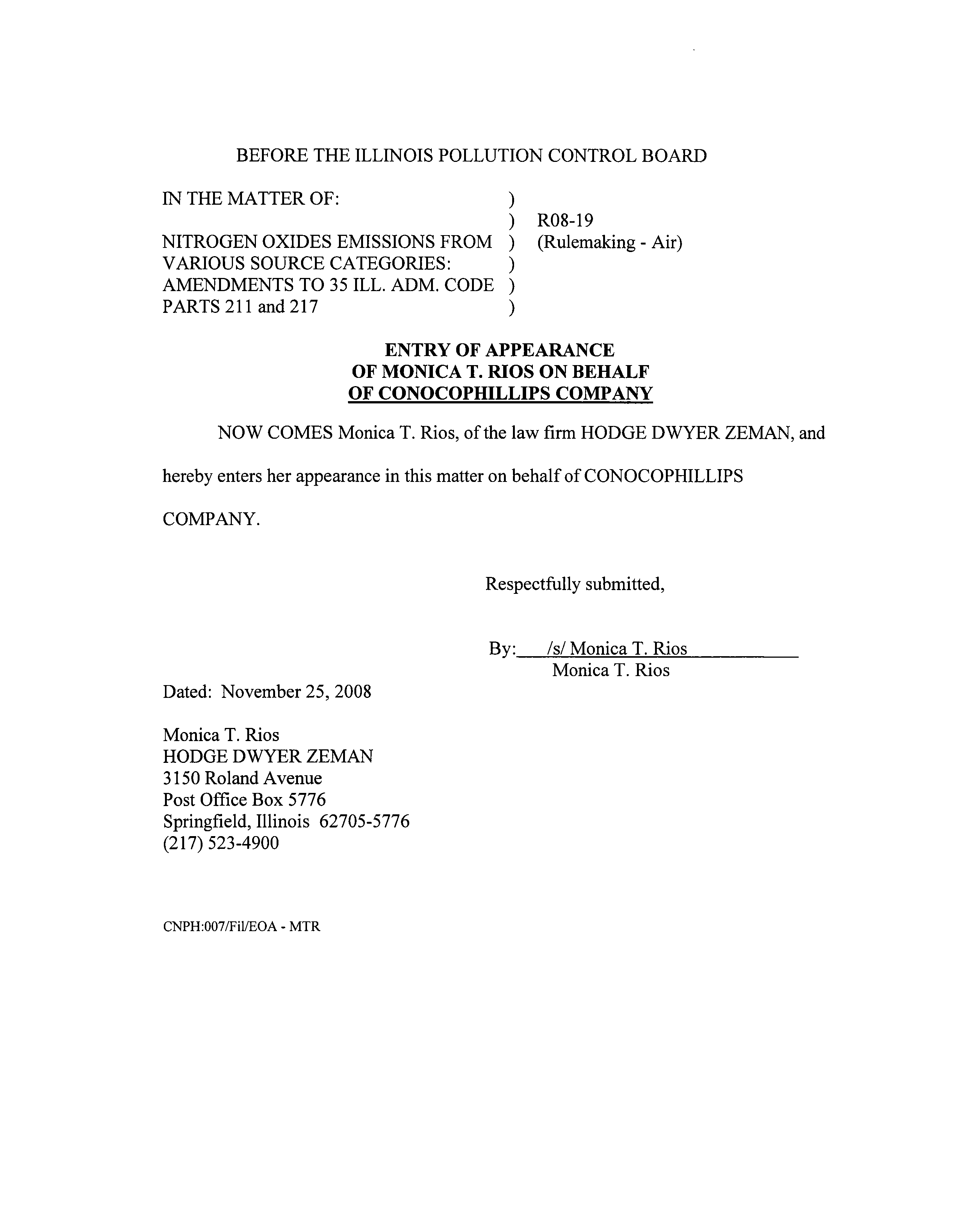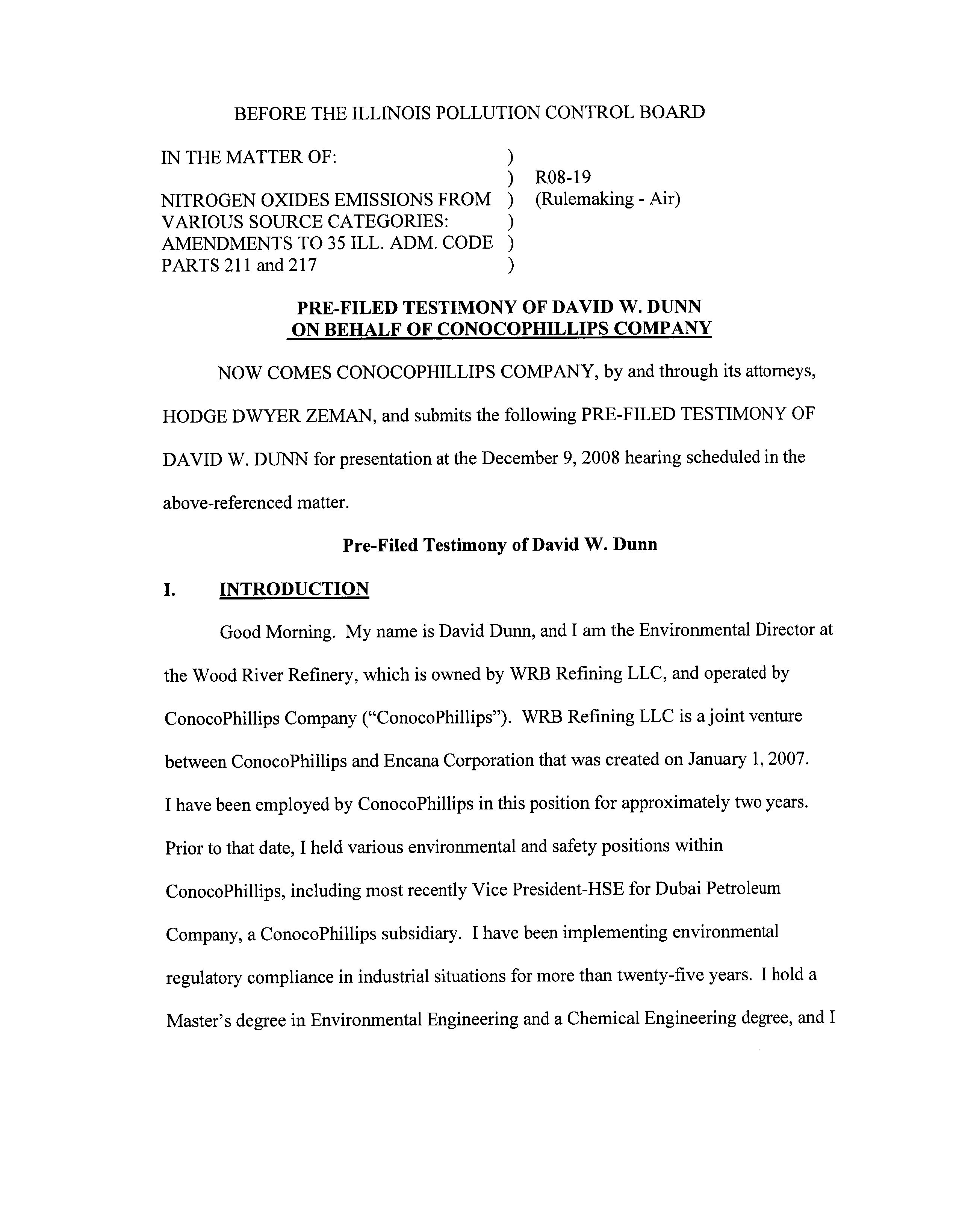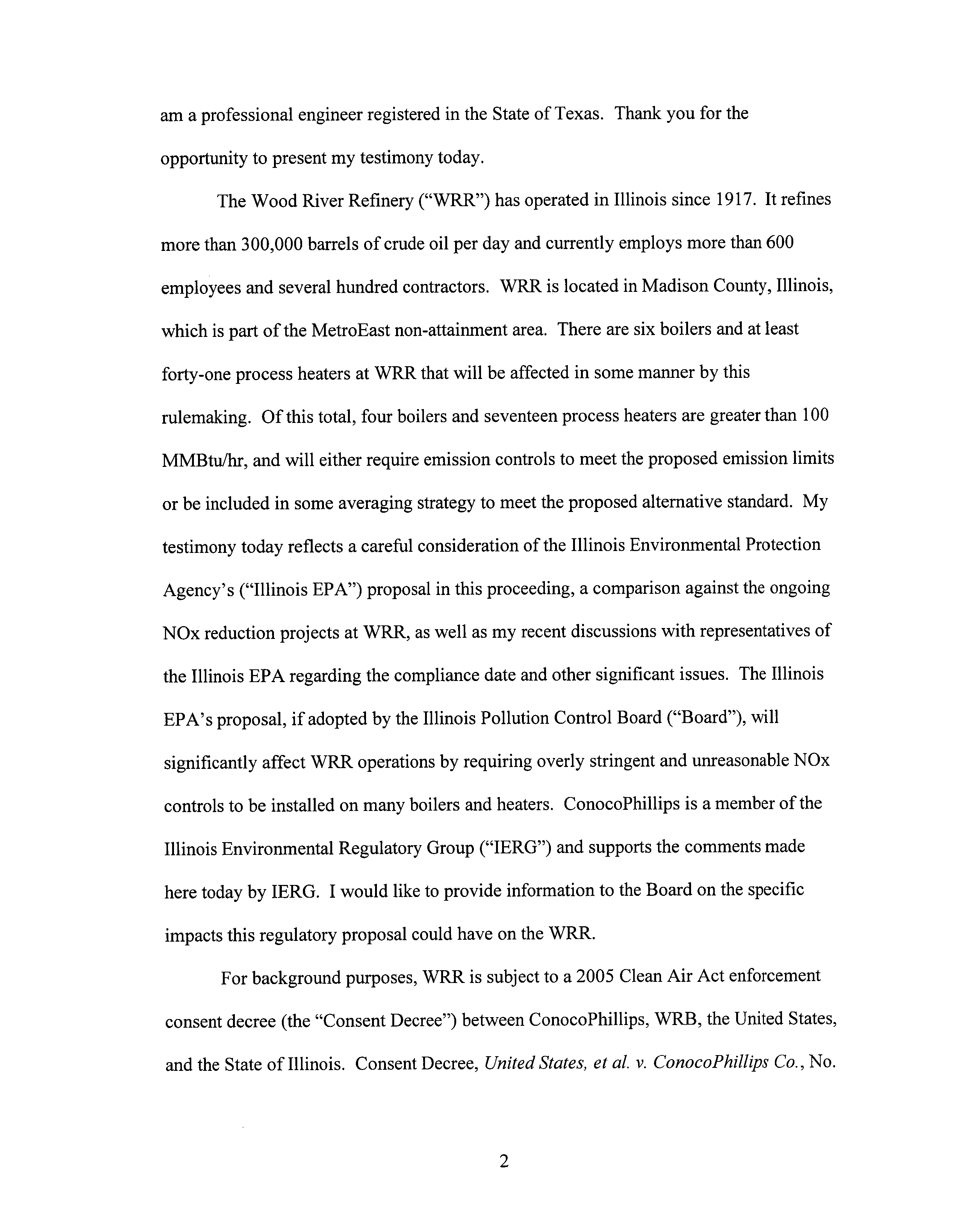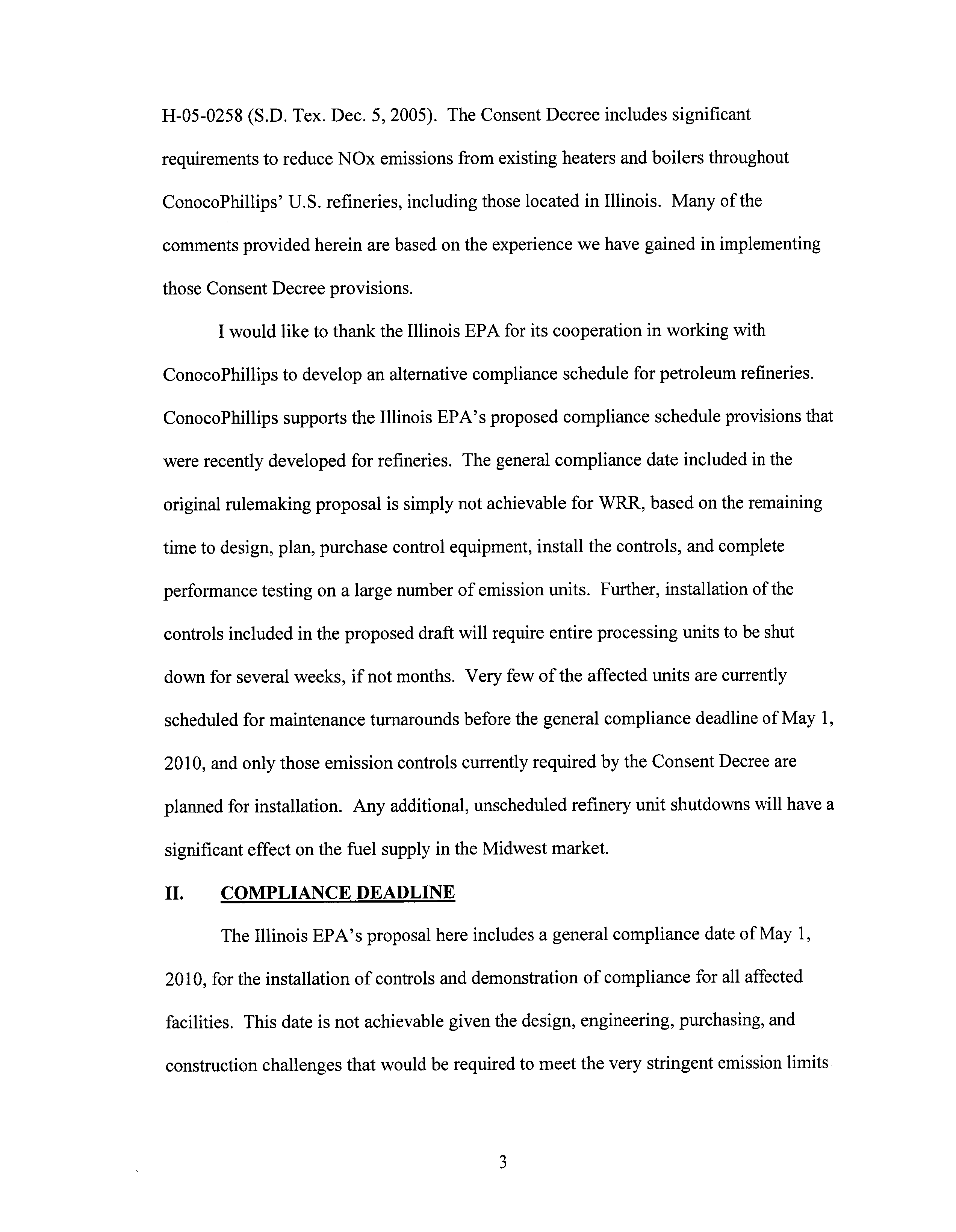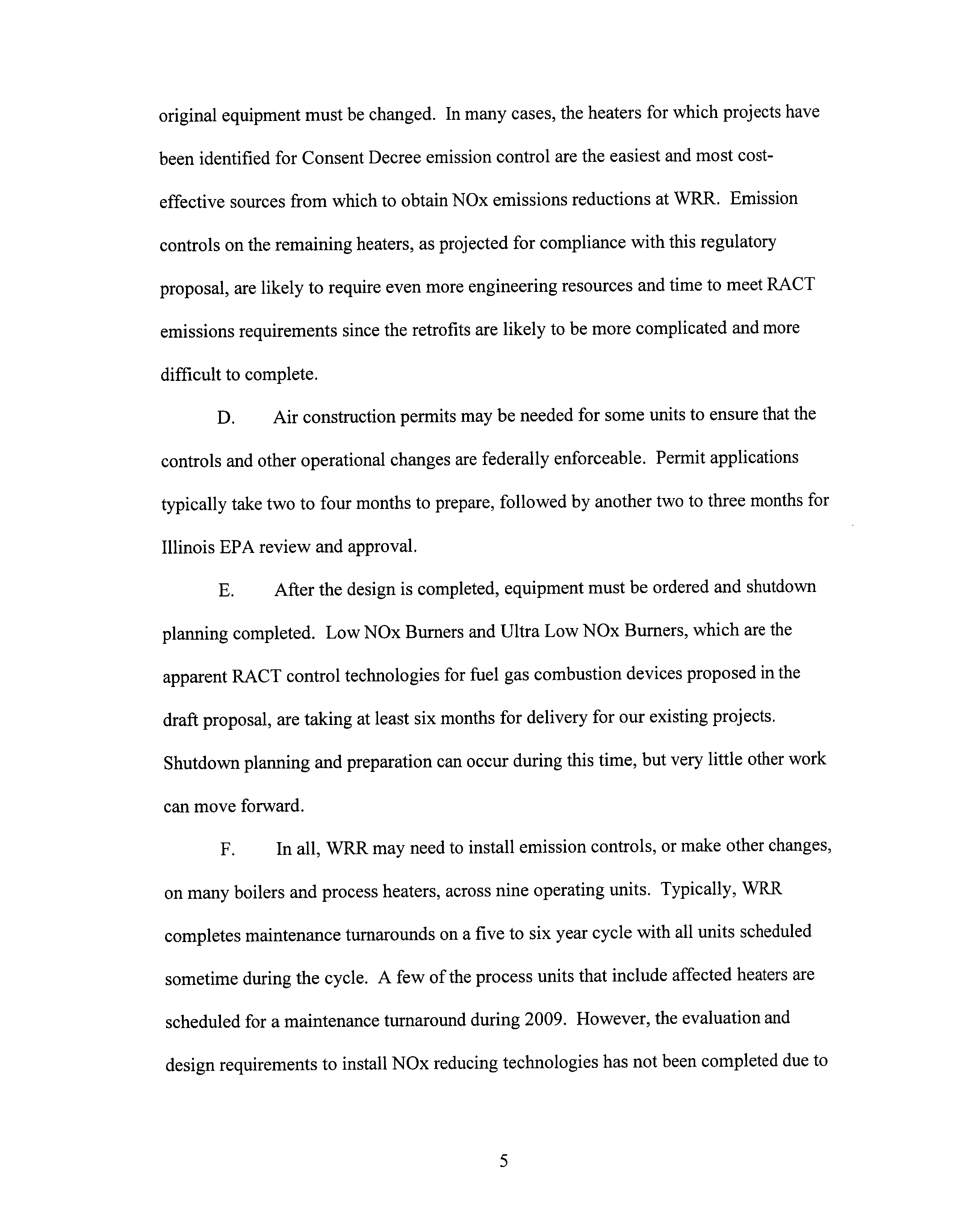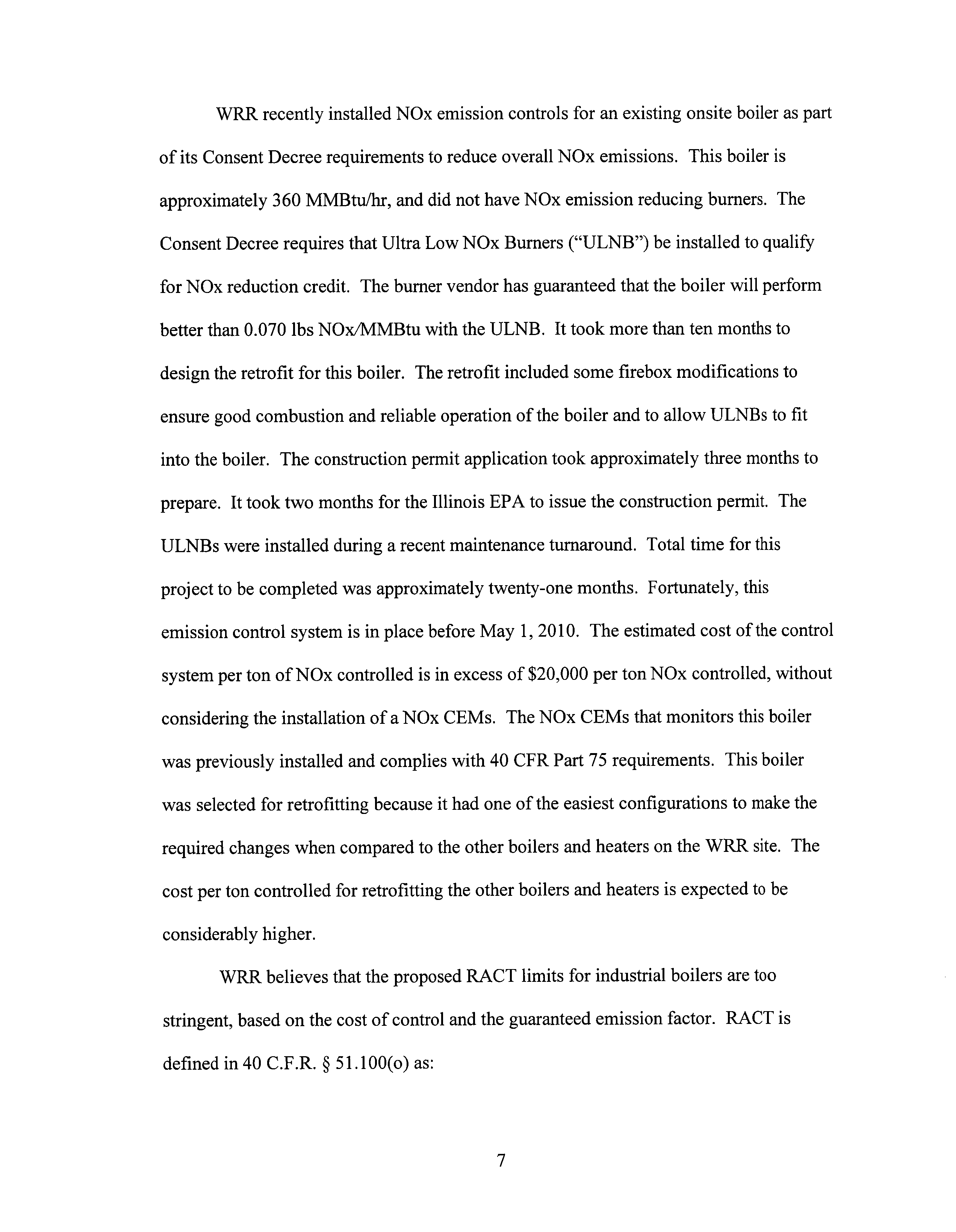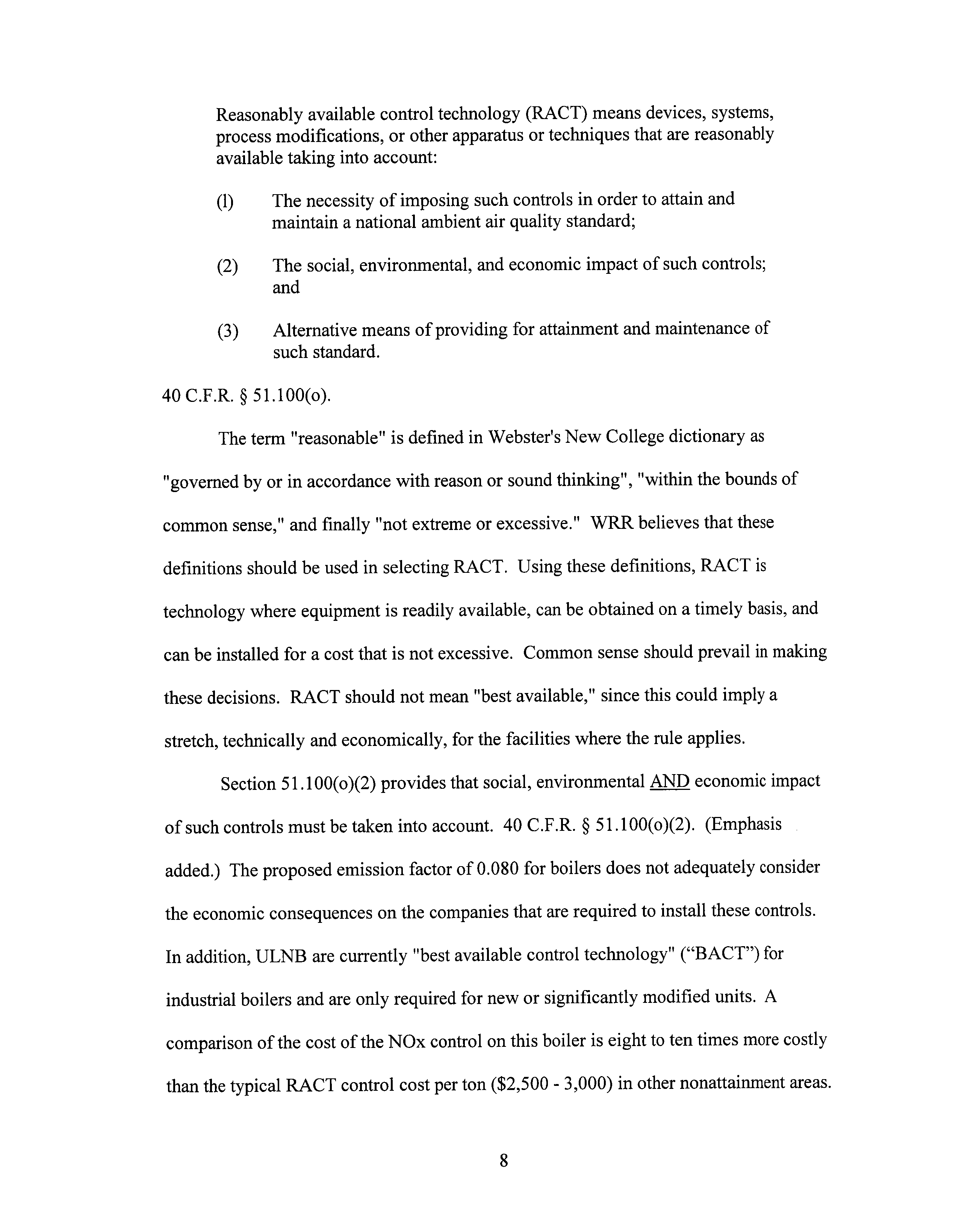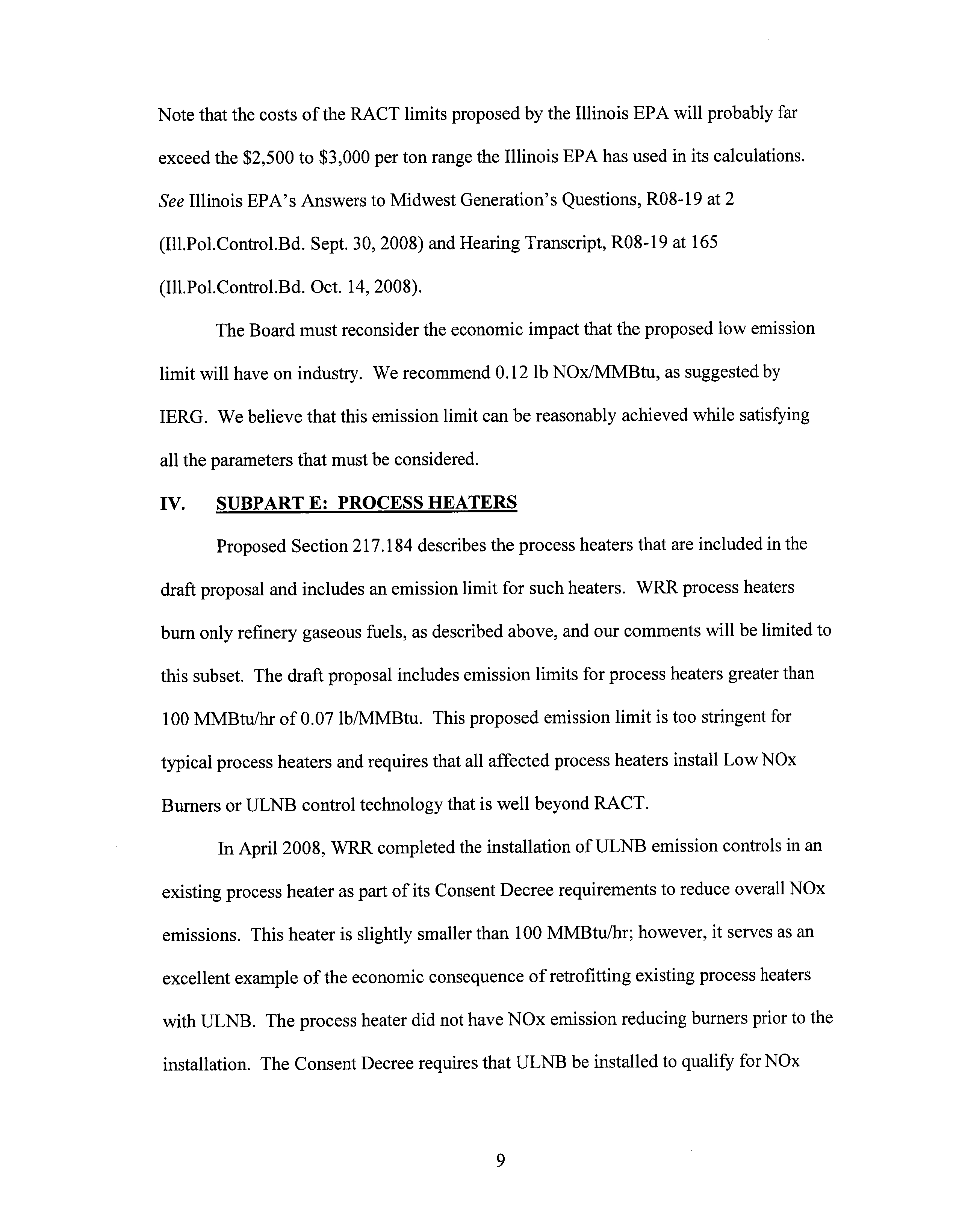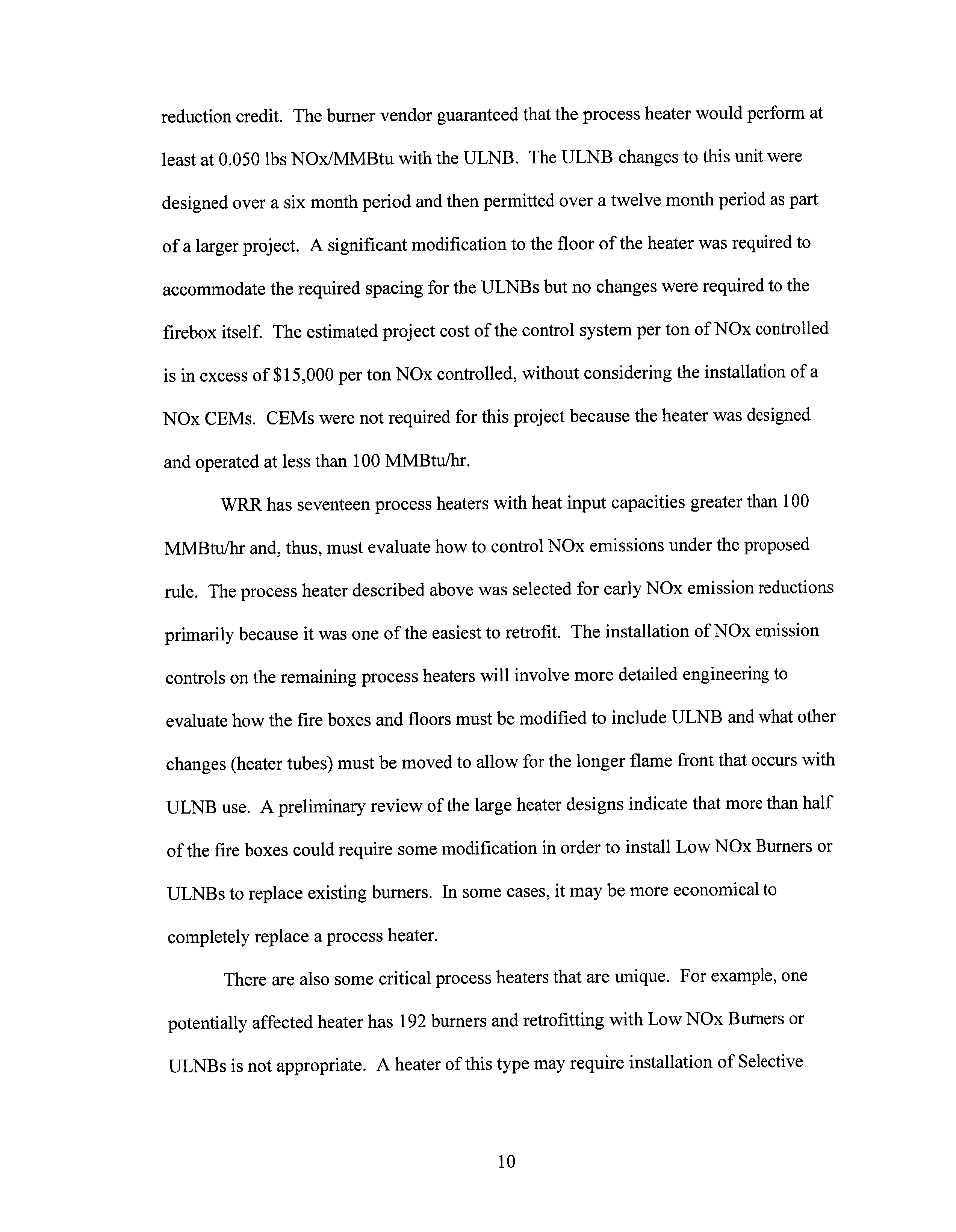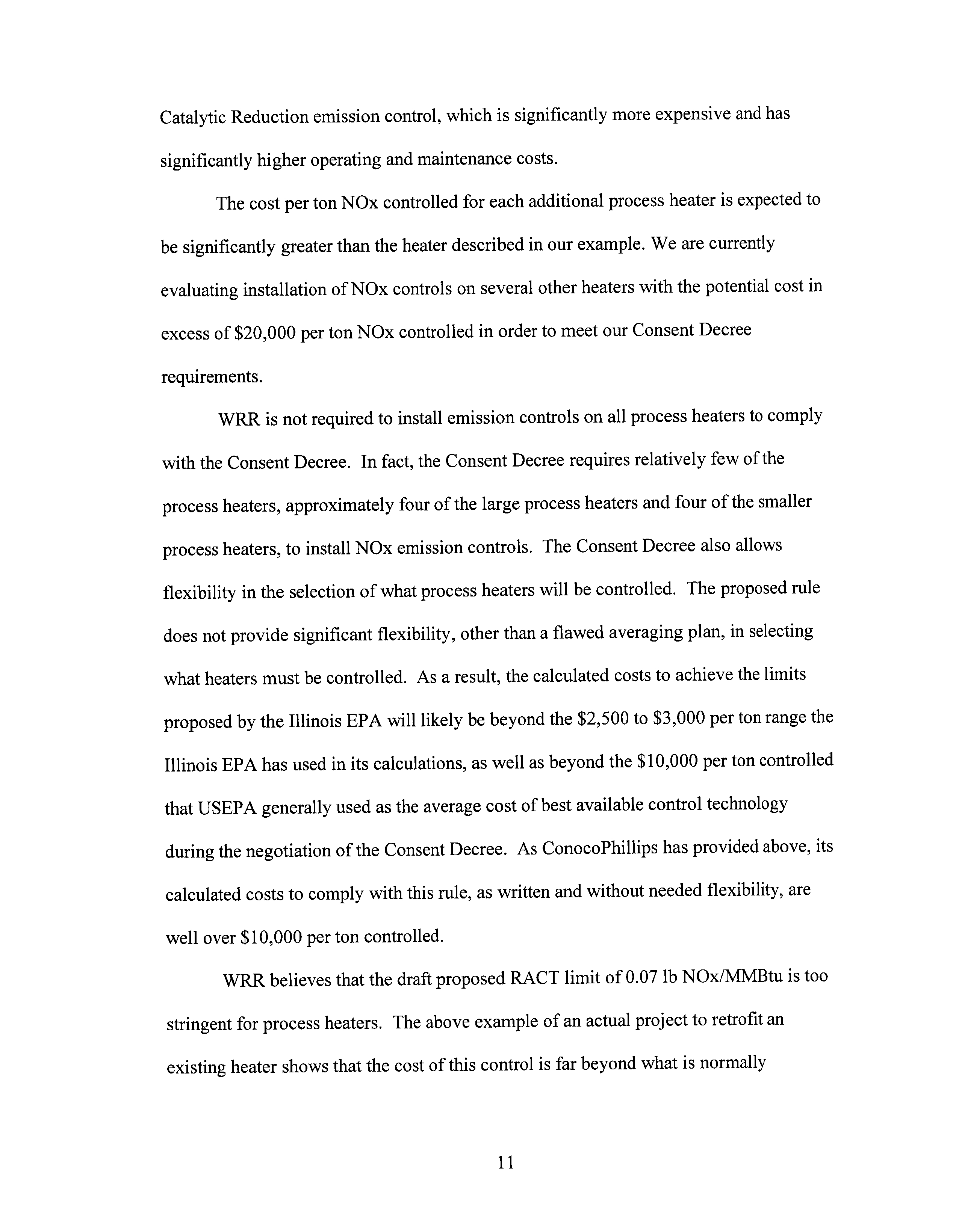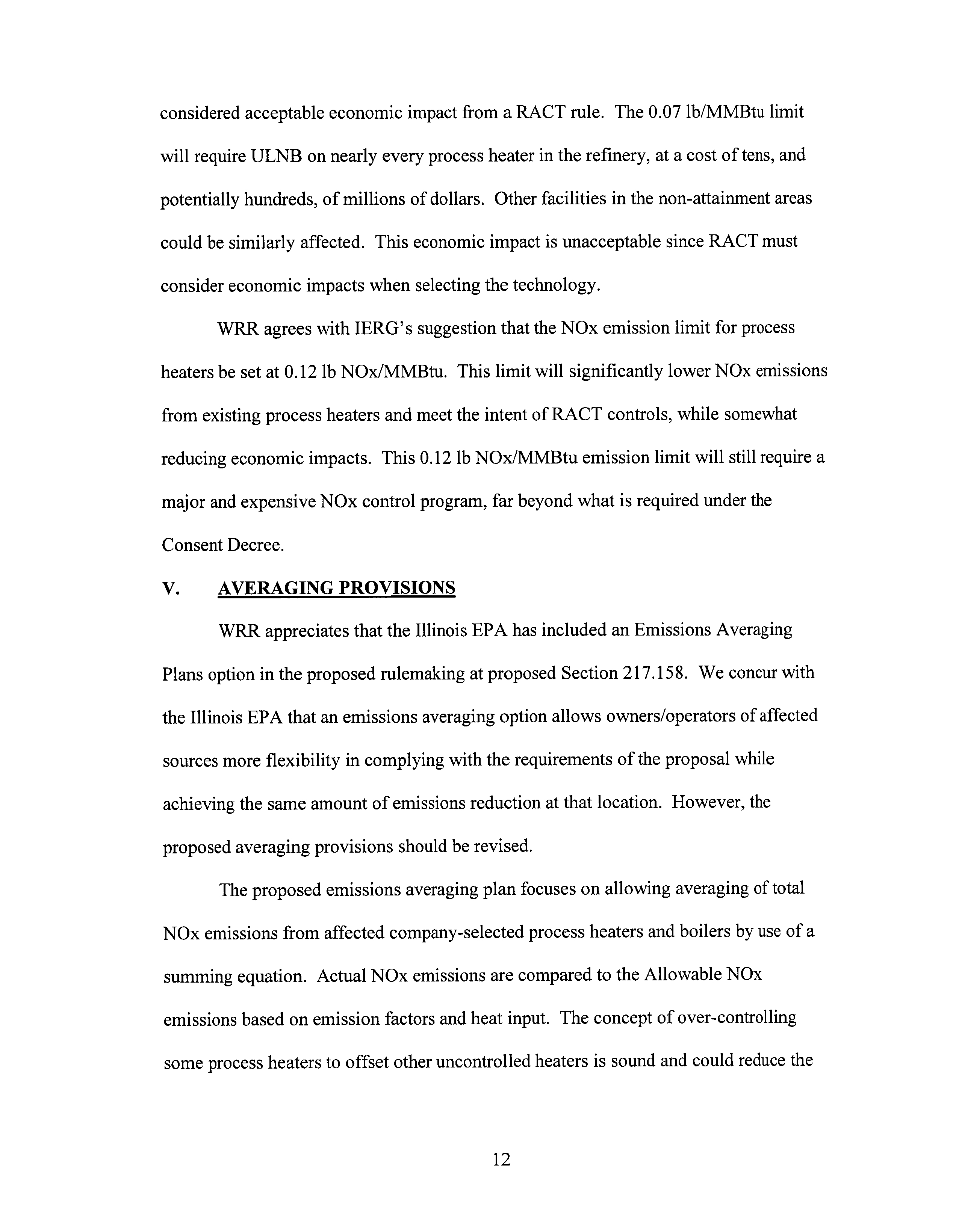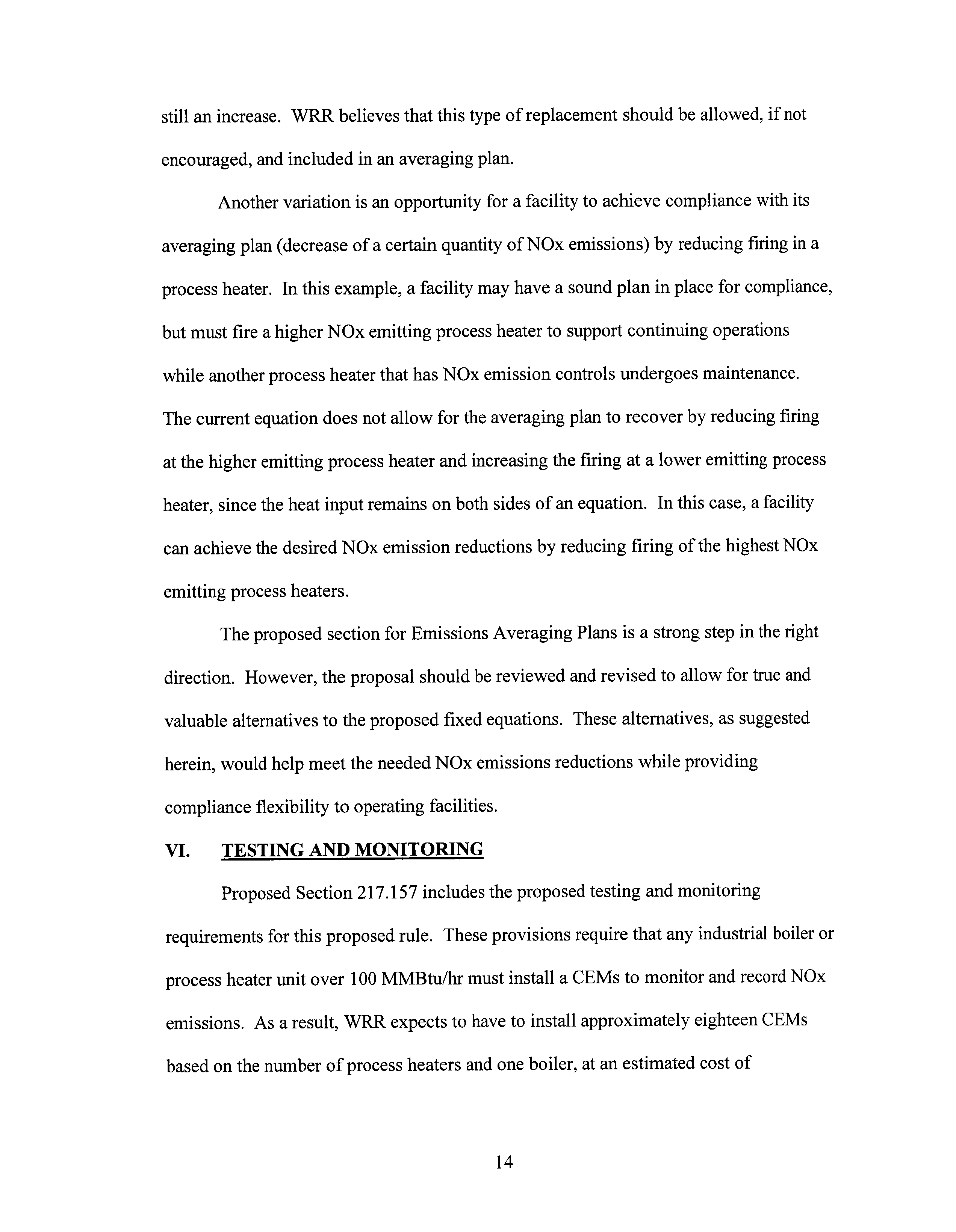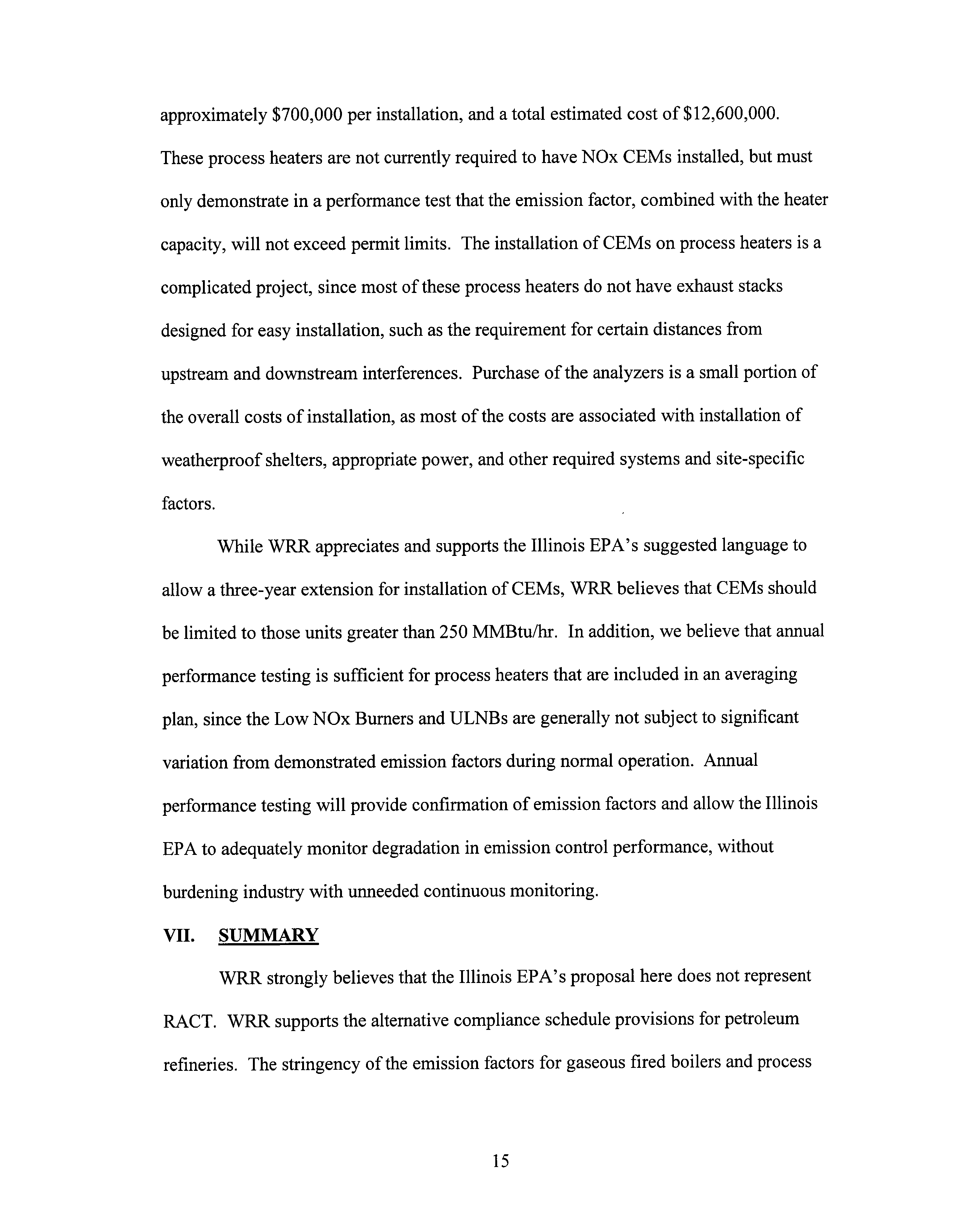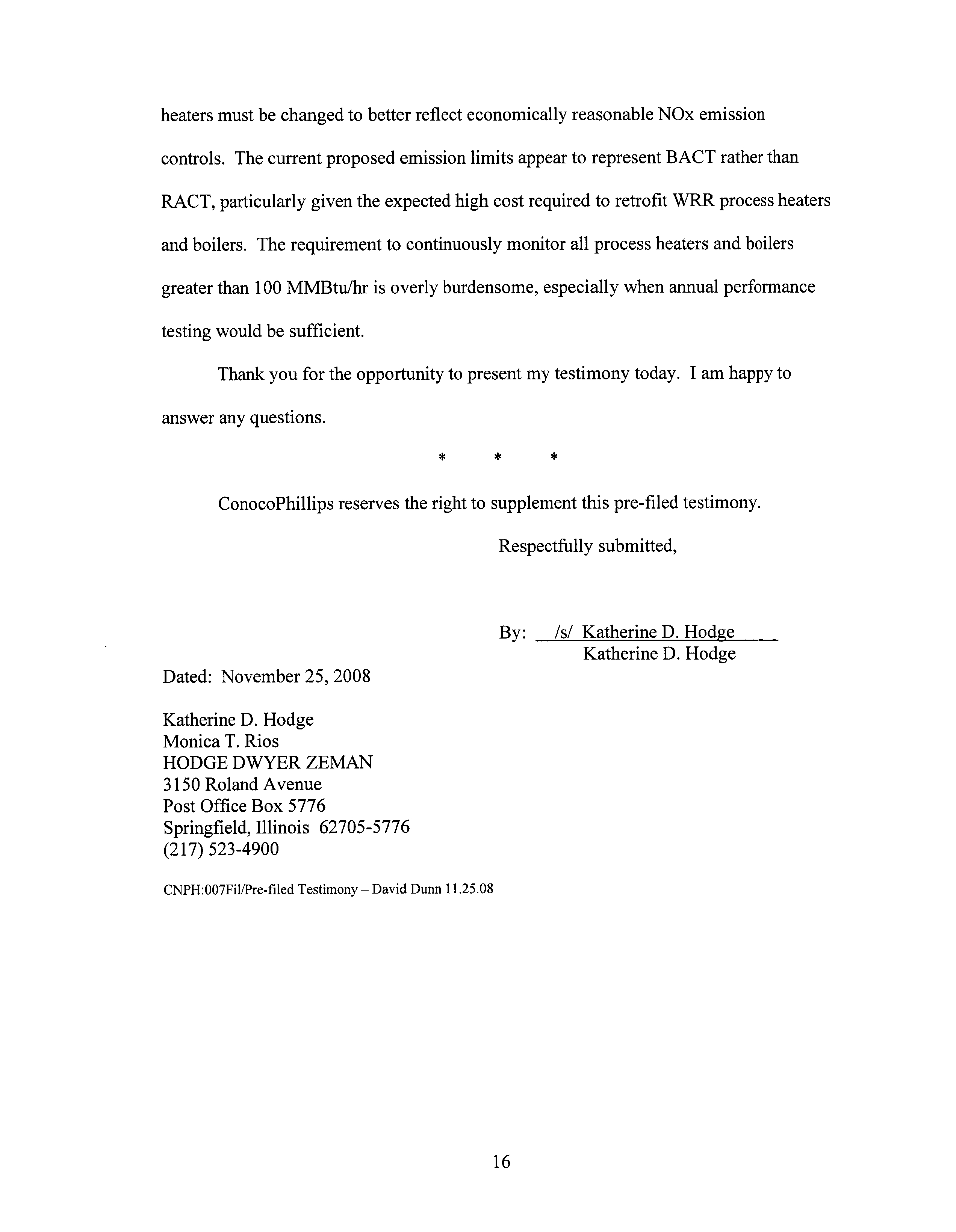BEFORE THE ILLINOIS POLLUTION CONTROL BOARD
IN THE MATTER OF:
)
NITROGEN OXIDES EMISSIONS FROM )
VARIOUS SOURCE CATEGORIES: )
AMENDMENTS TO 35 ILL. ADM. CODE )
PARTS 211 and 217
)
R08-19
(Rulemaking - Air)
NOTICE OF FILING
TO: Mr. John T. Therriault
Assistant Clerk of the Board
Illinois Pollution Control Board
100 W. Randolph Street
Suite 11-500
C hicago, Illinois 60601
(VIA ELECTRONIC MAIL)
Timothy Fox, Esq.
Hearing Officer
Illinois Pollution Control
100 W. Randolph Street
Suite I1-500
C hicago, Illinois 60601
(VIA FIRST CLASS MAIL)
Board
(SEE PERSONS ON ATTACHED SERVICE LIST)
PLEASE TAKE NOTICE that I have today filed with the Office of the Clerk of
the Illinois Pollution Control Board the ENTRY OF APPEARANCE OF
KATHERINE D. HODGE ON BEHALF OF CONOCOPHILLIPS COMPANY,
ENTRY OF APPEARANCE OF MONICA T. RIOS ON BEHALF OF CONOCO
PHILLIPS COMPANY and PRE-FILED
TESTIMONY
OF
DAVID W. DUNN
ON
BEHALF OF CONOCOPHILLIPS COMPANY, copies of which are herewith served
upon you.
Respectfully submitted,
By: /s/ Katherine D. Hodge
Katherine D. Hodge
Dated: November 25,
2008
Katherine D. Hodge
Monica T. Rios
HODGE DWYER ZEMAN
3150 Roland Avenue
Post Office
Box 5776
Springfield, Illinois 62705-5776
(217) 523-4900
THIS FILING SUBMITTED ON RECYCLED
PAPER
Electronic Filing - Received, Clerk's Office, November 25, 2008
CERTIFICATE OF SERVICE
1, Katherine D. Hodge,
the undersigned, hereby certify that I have served
the attached
ENTRY OF APPEARANCE OF
KATHERINE D. HODGE ON BEHALF OF
CONOCOPHILLIPS
COMPANY, ENTRY OF
APPEARANCE OF MONICA T. RIOS ON
BEHALF OF CONOCOPHILLIPS
COMPANY and PRE-FILED
TESTIMONY OF DAVID W.
DUNN ON BEHALF OF CONOCOPHILLIPS
COMPANY upon:
Mr. John T. Therriault
Assistant Clerk of the Board
Illinois Pollution Control
Board
1
00
West Randolph Street, Suite 11-500
Chicago, Illinois 60601
via electronic mail on November 25, 2008;
and upon:
Timothy Fox,
Esq.
Hearing Officer
Illinois Pollution Control
Board
100
West Randolph, Suite 11-500
Chicago, Illinois 60601
Matthew
J. Dunn, Esq.
Chief, Environmental Bureau North
Office of the Attorney General
69 West Washington Street, Suite 1800
Chicago, Illinois 60602
Gina Roccaforte,
Esq.
John J. Kim, Esq.
Division of Legal Counsel
Illinois
Environmental Protection Agency
1021 North Grand Avenue East
Post Office Box
19276
Springfield,
Illinois 62794-9276
Virginia Yang,
Esq.
Deputy Legal Counsel
Illinois Department of Natural
Resources
One Natural
Resources Way
Springfield,
Illinois 62701-1271
Kathleen C. Bassi, Esq.
Stephen J. Bonebrake,
Esq.
Schiff
Hardin, LLP
6600 Sears Tower
233 South Wacker
Drive
Chicago,
Illinois 60606-6473
by depositing
said documents in the United States
Mail, postage prepaid, in
Springfield, Illinois
on November 25, 2008.
/s/
Katherine D. Hodge
Katherine D. Hodge
CNPH:007Fi1/COS - Pre-Filed Testimony
of David Dunn
Electronic Filing - Received, Clerk's Office, November 25, 2008
BEFORE
THE ILLINOIS POLLUTION CONTROL BOARD
IN THE MATTER OF:
)
R 08-19
NITROGEN OXIDES
EMISSIONS FROM ) (Rulemaking - Air)
VARIOUS SOURCE
CATEGORIES:
)
AMENDMENTS TO 35 ILL. ADM. CODE )
PARTS 211 and 217
)
ENTRY
OF APPEARANCE
OF
KATHERINE D. HODGE ON
BEHALF OF CONOCOPHILLIPS COMPANY
NOW COMES
Katherine D. Hodge, of the law firm HODGE
DWYER ZEMAN,
and hereby enters her appearance in this matter on behalf of
CONOCOPHILLIPS
COMPANY.
Respectfully submitted,
By: /s/ Katherine
D. Hodge
Katherine D. Hodge
Dated: November 25, 2008
Katherine D. Hodge
HODGE DWYER
ZEMAN
3150
Roland Avenue
Post Office Box 5776
Springfield, Illinois 62705-5776
(217) 523-4900
CNPH:007/Fi1/EOA
- KDH
Electronic Filing - Received, Clerk's Office, November 25, 2008
BEFORE THE ILLINOIS POLLUTION
CONTROL BOARD
IN THE MATTER OF:
)
R08-19
NITROGEN OXIDES EMISSIONS FROM ) (Rulemaking - Air)
VARIOUS SOURCE CATEGORIES: )
AMENDMENTS TO 35 ILL. ADM.
CODE
)
PARTS 211 and 217
)
ENTRY OF APPEARANCE
OF MONICA T. RIOS ON BEHALF
OF CONOCOPHILLIPS COMPANY
NOW COMES Monica T. Rios, of the law firm HODGE DWYER ZEMAN, and
hereby enters her appearance in this matter on behalf of CONOCOPHILLIPS
COMPANY.
Respectfully submitted,
By: /s/ Monica T. Rios
Monica T. Rios
Dated: November 25, 2008
Monica T. Rios
HODGE
DWYER ZEMAN
3150
Roland Avenue
Post Office Box 5776
Springfield, Illinois 62705-5776
(217) 523-4900
CNPH:007/FiUEOA - MTR
Electronic Filing - Received, Clerk's Office, November 25, 2008
BEFORE THE ILLINOIS
POLLUTION CONTROL BOARD
IN THE MATTER
OF:
)
R08-19
NITROGEN
OXIDES EMISSIONS FROM ) (Rulemaking
- Air)
VARIOUS SOURCE CATEGORIES:
)
AMENDMENTS TO 35
ILL. ADM. CODE )
PARTS 211 and 217
)
PRE-FILED TESTIMONY OF
DAVID W. DUNN
ON BEHALF OF CONOCOPHILLIPS
COMPANY
NOW COMES
CONOCOPHILLIPS COMPANY,
by and through its attorneys,
HODGE
DWYER ZEMAN, and submits
the following PRE-FILED TESTIMONY
OF
DAVID W. DUNN for
presentation at the December 9, 2008
hearing scheduled in the
above-referenced
matter.
Pre-Filed Testimony
of David W. Dunn
I. INTRODUCTION
Good Morning. My name is
David Dunn, and I am the Environmental
Director at
the Wood River Refinery,
which is owned by WRB Refining
LLC, and operated by
ConocoPhillips Company ("ConocoPhillips").
WRB Refining LLC is a joint
venture
between ConocoPhillips
and Encana Corporation that
was created on January 1, 2007.
1 have been
employed by ConocoPhillips
in this position for approximately two years.
Prior to that date, I held various
environmental and safety positions
within
ConocoPhillips,
including most recently Vice
President-HSE for Dubai Petroleum
Company, a ConocoPhillips subsidiary.
I have been implementing environmental
regulatory compliance
in industrial situations for
more than twenty-five years. I hold a
Master's degree in Environmental
Engineering and a Chemical Engineering
degree, and I
Electronic Filing - Received, Clerk's Office, November 25, 2008
am a professional
engineer registered in the State of Texas. Thank
you for the
opportunity to present my testimony today.
The Wood River
Refinery ("WRR") has operated in Illinois since
1917. It refines
more
than 300,000 barrels of crude oil per day and
currently employs more than 600
employees and several
hundred contractors. WRR is located in Madison County, Illinois,
which is part of
the MetroEast non-attainment area. There
are six boilers and at least
forty-one process heaters at WRR that
will be affected in some manner by this
rulemaking. Of this total,
four boilers and seventeen process heaters are
greater than 100
MMBtu/hr,
and will either require emission controls
to meet the proposed emission limits
or be included in some
averaging strategy to meet the proposed alternative standard.
My
testimony today
reflects a careful consideration of the
Illinois Environmental Protection
Agency's ("Illinois EPA") proposal
in this proceeding, a comparison against
the ongoing
NOx reduction projects
at WRR, as well as my recent discussions
with representatives of
the Illinois EPA regarding the compliance
date and other significant issues. The Illinois
EPA's proposal, if adopted
by the Illinois Pollution Control Board ("Board"),
will
significantly
affect WRR operations by requiring
overly stringent and unreasonable NOx
controls to be installed on
many boilers and heaters. ConocoPhillips
is a member of the
Illinois Environmental
Regulatory Group ("IERG") and
supports the comments made
here today by IERG. I would like
to provide information to the Board
on the specific
impacts this regulatory
proposal could have on the WRR.
For background purposes, WRR
is subject to a 2005 Clean Air Act
enforcement
consent decree (the "Consent
Decree") between ConocoPhillips,
WRB, the United States,
and the State
of Illinois. Consent Decree, United
States, et al. v. ConocoPhillips Co.,
No.
Electronic Filing - Received, Clerk's Office, November 25, 2008
H-05-0258 (S.D. Tex. Dec. 5, 2005). The Consent
Decree includes significant
requirements to reduce
NOx emissions from existing heaters and boilers throughout
ConocoPhillips' U.S. refineries, including those located in Illinois. Many
of
the
comments provided herein are based on
the experience we have gained in implementing
those Consent
Decree provisions.
I would like to thank the Illinois EPA
for its cooperation in working with
ConocoPhillips to
develop an alternative compliance schedule for petroleum
refineries.
ConocoPhillips supports the Illinois EPA's proposed
compliance schedule provisions that
were recently developed for
refineries. The general compliance date included in the
original rulemaking proposal is simply not achievable
for WRR, based on the remaining
time to design, plan, purchase control equipment,
install the controls, and complete
performance testing
on a large number of emission units. Further,
installation of the
controls included in the proposed draft will require
entire processing units to be shut
down for several weeks,
if not months. Very few of the affected units are
currently
scheduled for maintenance turnarounds before
the general compliance deadline of May 1,
2010, and only those emission controls
currently required by the Consent
Decree
are
planned
for installation. Any additional, unscheduled
refinery unit shutdowns will have a
significant effect on the fuel supply in the
Midwest market.
II. COMPLIANCE DEADLINE
The Illinois EPA's proposal here
includes a general compliance date of May 1,
2010, for the installation of
controls and demonstration of compliance
for all affected
facilities. This date is not achievable given
the design, engineering, purchasing, and
construction challenges that would
be required to meet the very stringent
emission limits
Electronic Filing - Received, Clerk's Office, November 25, 2008
noted in the draft proposal. There are several
reasons why the proposed rule should
include an alternative
compliance date for petroleum refineries,
as follows:
A.
As of the date of this hearing, only
approximately seventeen months
remain before compliance
must be certified. The proposed regulation
is
still
just at
proposal and affected entities are not certain with
what they must comply. WRR has not
prepared a detailed compliance plan at
this time, since it is unclear what we must
include
in the plan.
B.
Every potentially affected heater
and boiler at WRR must be carefully
evaluated to determine the
most efficient compliance plan. This evaluation
must include
assessments of existing controls, potential
future controls, potential future process
changes and economic considerations
before the WRR's compliance plan
can be
finalized.
The averaging plan included in the Illinois
EPA's proposal must be evaluated
to determine if certain equipment can be over-controlled
to balance out under-controlled
equipment. While
WRR has been assessing the impact of
the regulation in anticipation
of installing some form of emission controls
at some future time, full development of the
compliance plan is expected
to take WRR at least six months and
will probably remain
open to
modification several months after that
as more detailed engineering studies
are
completed on the affected boilers
and heaters.
C.
An engineering study must be completed
on each heater that must be
controlled after the compliance plan
is developed. WRR is in the process
of installing
NOx controls on several
heaters at this time as part of
the above-described Consent
Decree. The engineering phase of these
projects has been at least six
months and up to
ten months long, depending
on whether the heater fire box
must be modified and how the
Electronic Filing - Received, Clerk's Office, November 25, 2008
original equipment must
be changed. In many cases,
the heaters for which projects
have
been
identified for Consent Decree emission
control are the easiest
and most cost-
effective sources from which
to obtain NOx emissions reductions
at WRR. Emission
controls on the
remaining heaters, as projected
for compliance with this
regulatory
proposal, are likely to require
even more engineering resources
and time to meet RACT
emissions requirements
since the retrofits are likely
to be more complicated
and more
difficult
to complete.
D.
Air construction
permits may be needed
for some units to ensure that
the
controls and other
operational changes are
federally enforceable. Permit
applications
typically take two to four
months to prepare, followed by another
two to three months for
Illinois EPA review
and approval.
E.
After the design
is completed, equipment
must be ordered and shutdown
planning completed.
Low NOx Burners and Ultra
Low NOx Burners, which
are the
apparent
RACT control technologies
for fuel gas combustion
devices proposed in the
draft proposal, are taking
at least six months for delivery
for our existing projects.
Shutdown planning
and preparation can occur
during this time, but
very little other work
can move forward.
F.
In all,
WRR may need to install
emission controls, or
make other changes,
on many
boilers and process heaters,
across nine operating
units. Typically, WRR
completes maintenance
turnarounds on a five to six
year cycle with all units
scheduled
sometime during
the cycle. A few of
the process units that
include affected heaters are
scheduled for a maintenance
turnaround during
2009. However, the evaluation
and
design requirements
to install NOx reducing
technologies has
not been completed due
to
Electronic Filing - Received, Clerk's Office, November 25, 2008
the uncertainty of the final regulations
and the inability to complete the work before the
turnaround
begins. The remaining units are not scheduled before
the 2010 deadline but
instead are planned through 2015. Early, unscheduled
turnarounds to upgrade other
process heaters will
impact the Midwest fuel supply, including the entire state of
Illinois,
potentially causing significantly higher gasoline and diesel
fuel costs.
Based on these reasons, WRR
supports the alternative compliance schedule for
petroleum
refineries as proposed by the Illinois EPA. However,
in the future, we may
suggest minor revisions to the proposed language,
if necessary, to clarify any issues that
may be raised during
this proceeding.
III. SUBPART D: INDUSTRIAL BOILERS
Proposed Section 217.160
describes the industrial boilers that are included
in the
draft proposal and includes an emission limit for such
boilers. WRR industrial boilers
burn only gaseous fuels and our comments
will be limited to this subset. The gaseous
fuel that is burned
at the WRR site includes natural gas and
refinery gas. Refinery gas is
similar to natural gas, but includes other hydrocarbon
compounds that may increase NOx
emissions to some slight
degree. Refinery gas is a co-product of
the refining process and
is typically consumed by onsite heaters and boilers
to improve overall refining energy
efficiency and reduce flaring.
The draft proposal includes an emission limit
for boilers greater than 100
MMBtu/hr of 0.08 lb/MMBtu. This proposed
RACT emission limit is overly stringent
for typical gas-fired
industrial boilers. This emission limit
will require the equivalent of
Ultra Low NOx control technology
to ensure compliance and is well beyond RACT.
Electronic Filing - Received, Clerk's Office, November 25, 2008
WRR recently installed NOx emission controls
for an existing onsite boiler as part
of its Consent Decree
requirements to reduce overall NOx emissions. This boiler is
approximately
360 MMBtu/hr, and did not have NOx emission reducing burners.
The
Consent Decree requires that Ultra
Low NOx Burners ("ULNB") be installed to qualify
for NOx reduction credit. The burner vendor has guaranteed that the boiler
will perform
better than 0.0701bs NOx/MMBtu with the ULNB.
It took more than ten months to
design the
retrofit for this boiler. The retrofit included some firebox modifications
to
ensure good combustion and reliable operation of the boiler
and to allow ULNBs to fit
into the boiler. The construction
permit application took approximately three months to
prepare. It took two months for the Illinois EPA to issue the construction
permit. The
ULNBs were installed during a recent
maintenance turnaround. Total time for this
project to be completed was approximately twenty-one
months. Fortunately, this
emission control system is in place before
May 1, 2010. The estimated cost of the control
system per ton
of NOx controlled is in excess of $20,000 per ton
NOx controlled, without
considering the installation of a NOx CEMs. The
NOx CEMs that monitors this boiler
was previously installed and
complies with 40 CFR Part 75 requirements.
This
boiler
was selected for retrofitting because it had one of
the easiest configurations to make the
required changes when compared to the
other boilers and heaters on the WRR site. The
cost per ton
controlled for retrofitting the other boilers
and heaters is expected to be
considerably higher.
WRR believes
that the proposed RACT limits for
industrial boilers are too
stringent, based on the cost of control
and the guaranteed emission factor. RACT is
defined in 40 C.F.R. §
51.100(o) as:
Electronic Filing - Received, Clerk's Office, November 25, 2008
Reasonably
available control technology (RACT)
means devices, systems,
process modifications, or other apparatus
or techniques that are reasonably
available taking into account:
(1)
The necessity
of imposing such controls
in
order
to attain and
maintain a national ambient air
quality standard;
(2) The social, environmental,
and economic impact of such
controls;
and
(3)
Alternative means of providing
for attainment and maintenance of
such standard.
40 C.F.R. § 51.100(o).
The term "reasonable" is defined
in Webster's New College dictionary as
"governed by or in accordance
with reason or sound thinking", "within
the bounds of
common sense,"
and finally "not extreme or excessive."
WRR believes that these
definitions should be used in selecting
RACT. Using these definitions,
RACT is
technology where equipment
is readily available, can be
obtained on a timely basis, and
can be
installed for a cost that is not excessive.
Common sense should prevail
in making
these decisions. RACT should
not mean "best available,"
since this could imply a
stretch, technically
and economically, for
the facilities where the rule applies.
Section 51.100(o)(2) provides
that social, environmental
AND economic impact
of such controls must
be taken into account.
40 C.F.R. § 51.100(o)(2). (Emphasis
added.)
The proposed emission
factor of 0.080 for boilers does not adequately
consider
the economic consequences
on the companies that are
required to install these controls.
In addition,
ULNB are currently "best
available control technology" (`BACT")
for
industrial boilers and are only
required for new or significantly
modified units. A
comparison
of the cost of the NOx control
on this boiler is eight to
ten times more costly
than the typical RACT
control cost per ton ($2,500 - 3,000)
in other nonattainment areas.
Electronic Filing - Received, Clerk's Office, November 25, 2008
Note that
the costs of the RACT limits proposed by the Illinois
EPA will probably far
exceed the $2,500 to $3,000 per
ton range the Illinois EPA has used in its calculations.
See Illinois EPA's
Answers to Midwest Generation's Questions,
R08-19 at 2
(Il1.Pol.Control.Bd. Sept. 30, 2008) and
Hearing Transcript, R08-19 at 165
(I11.Pol.Control.Bd.
Oct. 14, 2008).
The Board must reconsider the economic
impact that the proposed low emission
limit will have on industry.
We recommend 0.121b NOx/MMBtu, as suggested
by
IERG. We believe that
this emission limit can be reasonably achieved
while satisfying
all the parameters that must be considered.
IV. SUBPART E: PROCESS
HEATERS
Proposed Section 217.184 describes the
process heaters that are included in the
draft proposal and includes
an emission limit for such heaters.
WRR process heaters
burn only
refinery gaseous fuels, as described above,
and our comments will be limited to
this subset. The draft proposal
includes emission limits for process heaters
greater than
100 MMBtu/hr
of 0.071b/MMBtu. This proposed emission
limit is too stringent for
typical process heaters and requires that
all affected process heaters install
Low NOx
Burners or ULN13 control
technology that is well beyond
RACT.
In April 2008, WRR completed the
installation of ULNB emission
controls in an
existing process heater as part
of its Consent Decree requirements
to reduce overall NOx
emissions.
This heater is slightly smaller than
100 MMBtu/hr; however, it serves
as an
excellent example of the economic
consequence of retrofitting
existing process heaters
with ULNB.
The process heater did not have
NOx emission reducing burners prior
to the
installation.
The Consent Decree
requires that ULNB be installed
to qualify for NOx
Electronic Filing - Received, Clerk's Office, November 25, 2008
reduction credit.
The burner vendor guaranteed
that the process heater would
perform at
least at 0.0501bs NOx/MMBtu
with the ULNB. The ULNB
changes to this unit were
designed over
a six month period and then permitted
over a twelve month period
as part
of a
larger project. A significant modification
to the floor of the
heater was required to
accommodate the required
spacing for the ULNBs
but no changes were required to the
firebox itself.
The estimated project cost
of the control system per ton
of NOx controlled
is in excess of $15,000 per
ton NOx controlled, without
considering the installation of
a
NOx CEMs.
CEMs were not required for this project
because the heater
was designed
and operated
at less than 100 MMBtu/hr.
WRR has seventeen
process heaters with
heat input capacities greater than 100
MMBtu/hr and,
thus, must evaluate how
to control NOx emissions
under the proposed
rule. The process heater
described above was selected
for early NOx emission
reductions
primarily
because it was one of the easiest
to retrofit. The installation
of NOx emission
controls on the remaining process
heaters will involve
more detailed engineering
to
evaluate how
the fire boxes and floors
must be modified to include ULNB
and what other
changes
(heater tubes) must be
moved to allow for the longer
flame front that occurs
with
ULNB use. A preliminary
review of the large
heater designs indicate
that more than half
of the
fire boxes could require some
modification in order to
install Low NOx Burners or
ULNBs
to replace existing
burners. In some cases,
it may be more economical
to
completely
replace a process heater.
There are also some critical
process heaters
that are unique. For example,
one
potentially affected
heater has 192 burners
and retrofitting with
Low NOx Burners or
ULNBs
is not appropriate. A
heater of this type may
require installation of
Selective
Electronic Filing - Received, Clerk's Office, November 25, 2008
Catalytic Reduction emission
control, which is significantly
more expensive and
has
significantly higher
operating and maintenance
costs.
The cost per ton NOx
controlled for each additional
process heater is expected
to
be significantly greater
than the heater described
in our example. We are
currently
evaluating
installation of NOx controls
on several other heaters
with the potential cost in
excess of $20,000 per ton NOx
controlled in order to
meet our Consent Decree
requirements.
WRR is not required
to install emission controls on
all process heaters to comply
with the Consent Decree.
In fact, the Consent
Decree requires relatively
few of the
process
heaters, approximately
four of the large process
heaters and four of the smaller
process heaters, to install
NOx emission controls.
The Consent Decree also
allows
flexibility in the
selection of what process
heaters will be controlled.
The proposed
rule
does not provide significant
flexibility, other than a flawed
averaging plan,
in selecting
what heaters must
be controlled. As a result,
the calculated costs
to achieve the limits
proposed
by the Illinois EPA
will likely be beyond
the $2,500 to $3,000 per ton
range the
Illinois EPA has used in
its calculations, as
well as beyond the $10,000
per ton controlled
that USEPA
generally used as the
average cost of best
available control technology
during the negotiation
of the Consent Decree.
As ConocoPhillips has provided
above, its
calculated costs
to comply with this rule,
as written and without
needed flexibility,
are
well over
$10,000 per ton controlled.
WRR believes
that the draft proposed
RACT limit of 0.071b
NOx/MMBtu is
too
stringent
for process heaters.
The above example
of an actual project
to retrofit an
existing heater shows
that the cost of this control
is far beyond
what is normally
Electronic Filing - Received, Clerk's Office, November 25, 2008
considered acceptable economic impact from a RACT rule. The 0.071b/MMBtu
limit
will require ULNB on nearly every
process heater in the refinery, at a cost of tens, and
potentially hundreds,
of millions of dollars. Other facilities in the non-attainment areas
could be similarly affected. This economic impact
is unacceptable since RACT must
consider economic impacts
when
selecting
the technology.
WRR agrees with IERG's suggestion that the NOx emission
limit for process
heaters be set at 0.121b NOx/MMBtu.
This limit will significantly lower NOx emissions
from existing process
heaters and meet the intent of RACT controls, while somewhat
reducing economic impacts. This 0.121b NOx/MMBtu
emission limit will still require a
major and expensive NOx control
program, far beyond what is required under the
Consent
Decree.
V. AVERAGING PROVISIONS
WRR
appreciates that the Illinois EPA has included an
Emissions Averaging
Plans option in the proposed rulemaking
at proposed Section 217.158. We concur with
the Illinois EPA that
an emissions averaging option allows owners/operators
of affected
sources more flexibility in complying with the
requirements of the proposal while
achieving the same amount
of emissions reduction at that location. However,
the
proposed
averaging provisions should be revised.
The proposed emissions
averaging plan focuses on allowing averaging
of total
NOx emissions
from affected company-selected process
heaters and boilers by use of a
summing equation. Actual NOx emissions
are compared to the Allowable
NOx
emissions based
on emission factors and heat input. The concept
of over-controlling
some process heaters to offset other uncontrolled
heaters is sound and could
reduce the
Electronic Filing - Received, Clerk's Office, November 25, 2008
overall cost to an affected
facility. The proposed equation at Section 217.158(f) appears
reasonable for most uses. However, as variations are applied, the equation fails
to
provide emission reduction credit where
it is appropriate.
For example, the proposed equation does not appear to allow credit for boilers and
process heaters that are no longer in use after 2001. WRR has, or
will have, at least four
process
heaters and boilers that may fall into this category. The equation does not allow
for this reduction, because it requires each process
heater to include the actual emission
factor times the heat input calculated
from the fuel flow meter and the heating value of
the fuel used during a given year. If no fuel is used, then no emissions are counted
in the
equation. However, the same equation is used
for
the
allowable emissions sum. In this
case,
the proposed allowable emission factor (0.07) must be multiplied by the same heat
input. Since there is no heat input, there
is no credit given for the shutdown of the unit.
Both the Actual emissions
and the Allowable emissions terms are zero tons, when the
Allowable emissions should be some positive tonnage
based on historic operation. WRR
believes that the Illinois EPA should
allow emissions from shut down process heaters and
boilers in the emissions averaging plan, based on the
highest annual heat input at a given
process heater or boiler since
2002.
Another
variation for consideration is when a new process
heater with ULNB
controls is installed after January 1,
2002, replaces one or more process heaters, in such a
way that it is excluded
from
Section
217.158(a)(1)(C), i.e., the new process heater is
not
used for the same purpose as the replacement
unit. The existing process heaters will be
shut down with
no emissions credit given (see previous paragraph) and the
resulting
emissions from the new process heater will be significantly
less than a replacement, but
Electronic Filing - Received, Clerk's Office, November 25, 2008
still an increase. WRR
believes that this type of replacement should
be allowed, if not
encouraged, and included in an averaging
plan.
Another
variation is an opportunity for a facility to achieve
compliance with its
averaging
plan (decrease of a certain quantity
of NOx emissions) by reducing firing
in a
process heater. In
this example, a facility may have a sound plan
in place for compliance,
but must fire
a higher NOx emitting process heater to
support continuing operations
while another process heater that
has NOx emission controls undergoes maintenance.
The current
equation does not allow for the averaging plan to
recover by reducing firing
at
the higher emitting process heater and
increasing the firing at a lower emitting process
heater, since the heat
input remains on both sides of an equation.
In this case, a facility
can achieve
the desired NOx emission reductions
by reducing firing of the highest NOx
emitting process heaters.
The proposed section for Emissions Averaging
Plans is a strong step in the right
direction. However, the proposal should
be reviewed and revised to allow
for true and
valuable alternatives
to the proposed fixed equations.
These alternatives, as suggested
herein,
would help meet the needed NOx emissions
reductions while providing
compliance flexibility to
operating facilities.
VI. TESTING
AND MONITORING
Proposed Section 217.157
includes the proposed testing
and monitoring
requirements
for this proposed rule. These provisions
require that any industrial boiler
or
process heater unit over 100 MMBtu/hr
must install a CEMs to
monitor and record NOx
emissions. As a
result, WRR expects to have
to install approximately eighteen CEMs
based on the number of process heaters
and one boiler, at an estimated
cost of
Electronic Filing - Received, Clerk's Office, November 25, 2008
approximately $700,000
per installation, and a total estimated cost of $12,600,000.
These process heaters are not currently required
to have NOx CEMs installed, but must
only demonstrate in a performance
test that the emission factor, combined with the heater
capacity, will not exceed permit limits. The installation
of CEMs on process heaters is a
complicated project, since
most of these process heaters do not have exhaust stacks
designed
for easy installation, such as the requirement for certain distances
from
upstream and downstream interferences.
Purchase of the analyzers is a small portion of
the overall costs of
installation, as most of the costs are associated with installation
of
weatherproof shelters, appropriate power, and other
required systems and site-specific
factors.
While
WRR appreciates and supports the Illinois EPA's suggested
language to
allow a three-year extension for
installation of CEMs, WRR believes that CEMs should
be limited to those
units greater than 250 MMBtu/hr. In addition,
we believe that annual
performance testing is sufficient for process
heaters that are included in an averaging
plan, since the
Low NOx Burners and ULNBs are generally not subject
to significant
variation
from demonstrated emission factors during
normal operation. Annual
performance testing will
provide confirmation of emission factors
and allow the Illinois
EPA to adequately
monitor degradation in emission control
performance, without
burdening industry with unneeded
continuous monitoring.
VII. SUMMARY
WRR strongly believes that the
Illinois EPA's proposal here does
not represent
RACT. WRR supports
the alternative compliance schedule
provisions for petroleum
refineries.
The stringency of the emission
factors for gaseous fired boilers
and process
Electronic Filing - Received, Clerk's Office, November 25, 2008
heaters must be changed to better
reflect economically reasonable NOx emission
controls. The current proposed emission limits appear to represent BACT
rather than
RACT, particularly given the expected high cost
required to retrofit WRR process heaters
and boilers.
The requirement to continuously monitor all process heaters and boilers
greater than 100 MMBtu/hr is overly burdensome,
especially when annual performance
testing would be sufficient.
Thank you for the opportunity to present my testimony today.
I am happy to
answer any questions.
ConocoPhillips reserves the right
to supplement this pre-filed testimony.
Respectfully submitted,
By: /s/ Katherine D. Hodge
Katherine D. Hodge
Dated: November
25, 2008
Katherine D. Hodge
Monica T. Rios
HODGE DWYER
ZEMAN
3150
Roland Avenue
Post Office Box 5776
Springfield, Illinois 62705-5776
(217) 523-4900
C NPR007Pi1/Pre-filed
Testimony-David Dunn 11.25.08
Electronic Filing - Received, Clerk's Office, November 25, 2008
